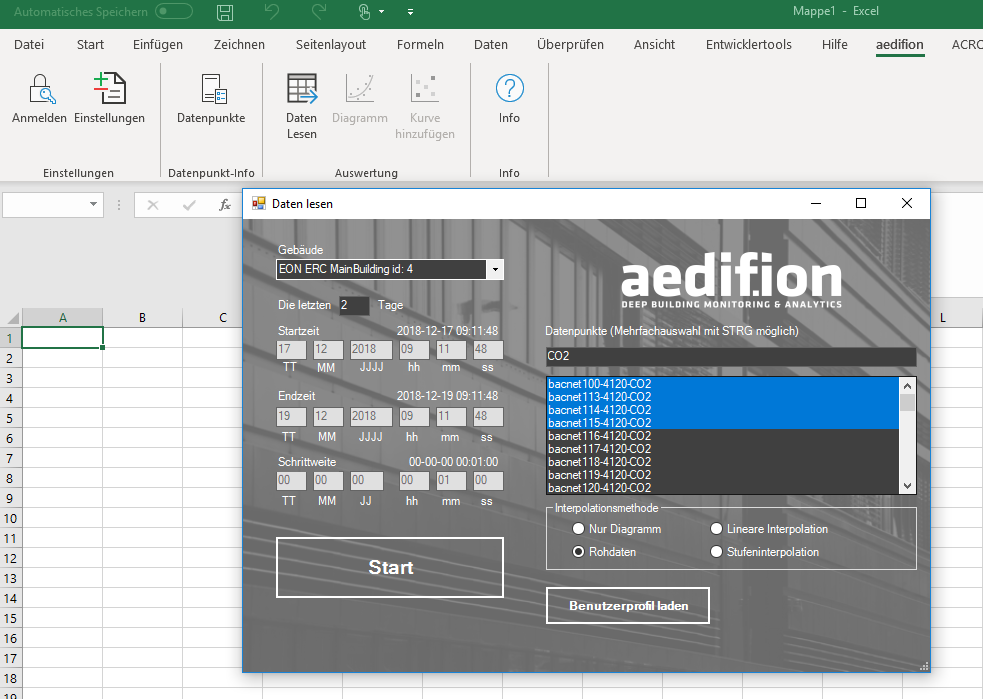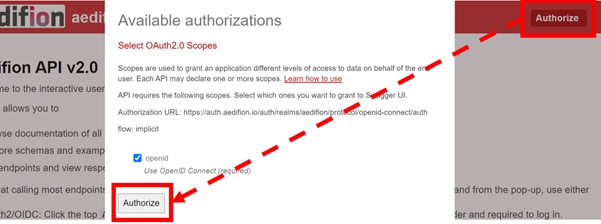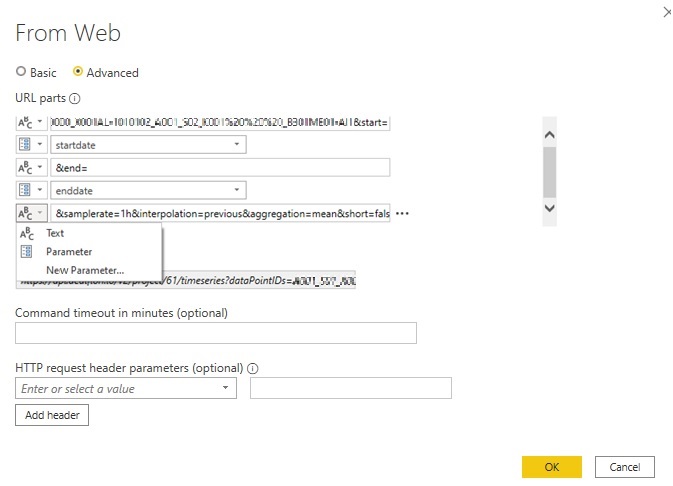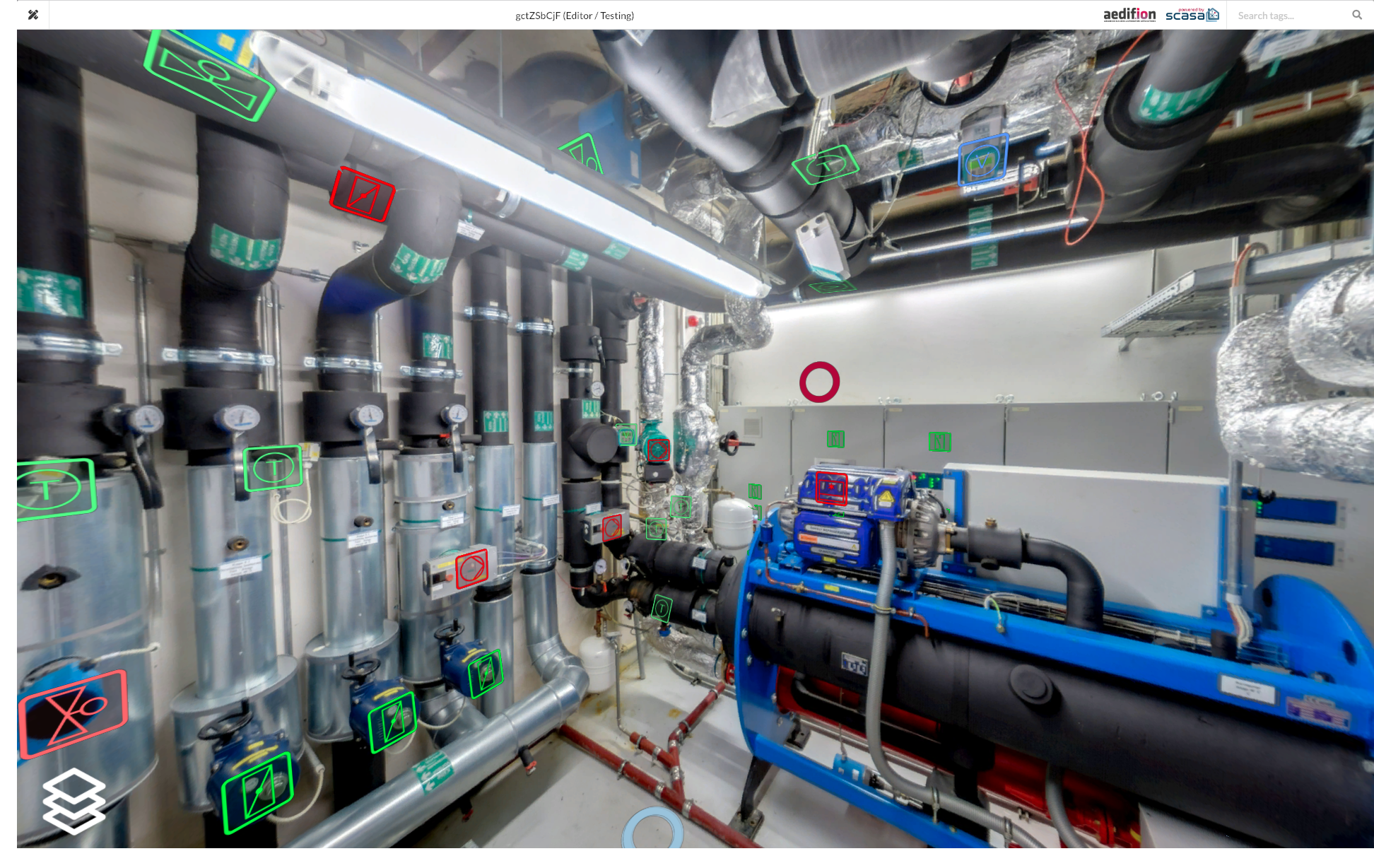Integrations
Overview of integrations and extensions of the aedifion.io cloud platform.
Excel¶
With aedifion's open source Excel Plugin, you can import data from aedifion.io using its HTTP API directly into your Excel sheet. You can query data from multiple datapoints over multiple projects and synchronize asynchronous CoV-based observations with adjustable sample rates and different interpolation methods, such as zero-order-hold (step interpolation). The retrieved data can be visualized in different types of automatically generated plots. The plugin is currently available for Windows and can be installed without admin rights.

Figure 1: Importing multiple timeseries from the aedifion.io HTTP API directly into an Excel sheet
Power BI¶
Power BI is a Microsoft analytics service aiming to provide interactive visualizations with an interface simple enough for end users to create their own reports and dashboards. It can make use of multiple datasources, including CSV files or direct HTTP requests to the aedifion API. Parameters can be added directly into the queries, making it easy to adjust the HTTP request, e.g., to change the datapoint id, samplerate or interval. The requested data can be parsed properly with a few steps that have to be defined once, typically including:
- Conversion to table
- Extraction of values
- Splitting column by delimiter
- Renaming columns
Once the query is applied, the parsing steps are applied automatically and the data can be utilized within many different visualizations.
The following section contains a tutorial on how to allow for direct data ingress from the aedifion API into the Power BI platform. Using this method, it is possible to input unlimited datapoints into Power BI using a single query.
First, one needs to attain the URL to the desired API endpoint by using the SwaggerUI.
Head over to the aedifion API user-interface using this link and log in via openid.

Navigate to the desired API endpoint, such as the one for:
Retrieving timeseries data for a single datapoint (GET /v2/datapoint/timeseries) or retrieving timeseries data for multiple datapoints (GET /v2/project/{project_id}/timeseries).
When activating the desired API endpoint, make sure to include all the parameters you would later want to turn into variables, such as start, end or max. Once initialized, the Request URL can be copied.

The request URL can then be inserted as a Web source in Power BI. Under the option "Advanced" the URL can also be provided with variables (so-called "parameters"). For this purpose, the URL must simply be divided into different parts and suitable parameters added.

The first time the query is executed, the login information is requested once.

Now the query has been created, can be easily manipulated using variables.
Chatbots¶
Our Telegram Chatbot receives real-time alerts from the aedifion.io platform and sends them to private or group chats. Typical use cases are, notifying about unwanted or even dangerous system conditions or detecting unscheduled shut-downs and outages. To facilitate a quick assessment and response to potential emergency conditions, the chatbot offers further interactive features that, e.g., allow quickly plotting critical datapoints and querying basic statistics directly from within the chat. Integration with other messengers such as Slack, or Teams is available on request.
Learn more? Start a conversation with @aedifion_bot or go to our tutorial on real-time alarms to explore its features.


Figure 2: Plotting a threshold alarm on CO2 concentration within a Telegram chat
3D HMI¶
Together with SCASA, aedifion offers high resolution 3D Visualizations with centimeter accuracy of your offices, installation rooms, or factory floor. aedifion augments 3D Visualizations with live data from the aedifion.io platform and even integrates controls. With this product, you can take virtual tours of your local site, e.g., to monitor and control components or determine a component's build to order a replacement -- with a browser from anywhere just as like being on site. By searching for a device with tag search you literally fly to the selected device.
Learn more? Experience the video of a 3D visualization or request a personal demo.

Figure 3: Taking a virtual tour through the ERC's installations room
Alexa¶
We have built skills for Amazon's Alexa to interact with the HTTP API of the aedifion.io platform allowing you to query and control your surroundings using natural language. E.g., you may turn down the heating in your office with a simple dialogue.
Learn more? Watch our demo video or request a personal demo.

Figure 4: Ask Alexa to turn down the heating
Cloud services¶
The aedifion.io platforms integrates with multiple cloud services for data ingress and egress. You can, e.g., ingest data from devices connected to Cumulocity, run analytics on it on the aedifion.io platform, and export data and results to your AWS S3 Bucket.
Third party data¶
We integrate different free third-party data sources with the aedifion.io platform that allow augmenting your building's data with, e.g., weather data.
Weather data¶
We integrate localized weather data for all projects. Weather data is accessible and visualizable on the platform like any other datapoint on the platform. It includes measured data as well as predictions with different horizons of several meteorological conditions such as temperature or dew point.
Learn more? Explore the integration specifications for more information.
Microsoft Exchange¶
aedifion.io is able to connect to customers' Microsoft Exchange servers. A typical use case is to take information on resources to find better control decisions, e.g. such as bookings of seminar rooms to control their HVAC systems.
Vendor integrations¶
We offer the integration of various loggers to make your data available to you using our cloud platform. Check out a quick overview of the functional scope for the available integrations. Below you will find a more detailed description of the available integrations.
Contact us, if you want to gather data from other services to our cloud or if you want to use another communication protocol for data transfer. We will also be happy to discuss an extension of existing connectivity with you.
ADS¶
The Automation Device Specification (ADS) is the communication protocol of TwinCAT. It enables the data exchange and the control of TwinCAT systems. Our Beckhoff ADS integration covers both the logging of measured data and meta data from the building automation network as well as the writing of values. This enables the recording of measured data including their meta data of the current operation as datapoints as well as an adjustment of the systems operation by writing setpoints.
Archibus¶
Our Archibus integration covers the integration of an Archibus-based room booking API. Through this integration, the room booking information can be captured as a datapoint. Thus, this information can be analyzed and used subsequently. Contact us to ensure that your Archibus-based room booking API is supported.
BACnet¶
Our BACnet integration covers both the logging of measured data and meta data from the building automation network as well as the writing of values. This enables the recording of measured data including their meta data of the current operation as datapoints as well as an adjustment of the systems operation by writing setpoints.
Comgy¶
We offer the integration of measurement data regarding heat, water and electricity consumption collected by Comgy using their API. Thus, we are able to store the data in our cloud, analyze it, and combine it with other data. This allows keeping an eye on your data across platforms and devices.
Cumulocity¶
The provided Cumulocity integration covers the logging of data from the Cumulocity platform via its API. Thereby logged values and meta data can be gathered and stored on our platform. These data are then available for display and analysis.
Discovergy¶
Our Discovergy integration covers the logging of data from the Discovergy platform via its API. This allows viewing and analyzing the current and past energy consumption determined by Discovergy's energy meters and compare it to your other plants.
GeorgFischer Hycleen¶
The GeorgFischer Hycleen integration of our multi logger covers the logging of data from and the writing of data to the GeorgFischer Master via its API. The recording includes measured data, meta data and the download of created reports. By writing setpoints to the master, it is possible to make adjustments to the system operation via the API. This enables influencing the operation of your plant.
Influx¶
We provide an Influx integration which enables the logging of data as well as the publishing of data to an Influx database. Thus, it is possible to use the InfluxDB platform, which is specialized in handling time-stamped data.
Kafka¶
Our Kafka integration covers publishing data from and to your building automation system using Kafka. This allows taking full advantage of the powerful Kafka pipeline and the Kafka cluster. Thus, you can use the advantages of the Kafka ecosystem, and our cloud platform centrally. Data logging is available on demand. Contact us, if you need data to be logged using Kafka.
KNX¶
The provided KNX integration covers logging and writing of data of a KNX network. Thus, information about your buildings operation can be requested and adjusted, e.g., via the Telegram desktop or mobile app. This makes it possible to keep an eye on plant operation even when you are on the road.
Kolibri¶
Our Kolibri integration covers the logging and writing of data using the Kolibri API. Thus, we are able to log observations and meta data from the Kolibri system and publish them to our cloud using an MQTT stream. We also offer the possibility to write data to the Kolibri system. This way, you can keep an eye on your data via our cloud platform and react to all changes.
Microsoft SQL¶
Using our Microsoft SQL integration, we are able to log data from your Microsoft SQL Server-based databases. Therefore, it is possible to save, analyze, and display the logged data using our cloud platform. In addition, the combination of the saved data with further data from other sources is possible.
Modbus¶
We offer the integration of Modbus based networks. This allows logging data from your equipment and writing setpoints, which enables the analysis and a modification of the equipment operation using our cloud. Thus, a Modbus based system can be used and connected to our cloud at the same time.
MQTT¶
Our MQTT integration enables the use of the MQTT protocol, which is a standard protocol for the IoT. It enables the exchange of information, e.g., meta data or measured values, even in networks with low bandwidth and saves resources at the same time. In addition, bidirectional communication between devices and the cloud is possible. Logging is available on demand, feel free to contact us.
ISIS IC CO2-Ampel
ISIS IC is sending the CO2-observations of their CO2 Ampel CONNY to the aedifion platform via MQTT.
Sensilla Solutions
Sensilla publishes all the measurements of their sensor device to the aedifion platform via MQTT. The measurements are:
- Particles
- TVOC
- CO2
- Air pressure
- Temperature
- Relative humidity
Integrators
Building automation integrators are already publishing into the aedifion platform via MQTT. Get in contact with us to find out who.
OPC DA¶
This integration offers the possibility to connect to OPC DA servers to transfer timeseries data, saved on this server, to our aedifion.io cloud platform. By transferring the data to aedifion's cloud platform, the data become available via the internet. This makes decentralized data from multiple servers and other sources available in one central platform, where the data can be analyzed or exported.
OPC UA¶
Operating data of your systems stored in OPC UA servers can be logged via our OPC UA integration and thus transferred to our cloud platform. This enables the analysis and review of data in combination with data from other sources centrally via our cloud platform.
Qivalo¶
The Qivalo integration logs collected meter readings by querying these data periodically from the Qivalo API. Logged meter readings are now available as timeseries data on the aedifion.io cloud platform and can be analyzed together with further operating data from the building. Thus, relations between the operation and the energy consumption of the building can be identified and the data are available via our API.
RDM DM¶
We offer the integration of the Resource Data Management's data manager device. Here it is possible to read in recorded data (measured values and meta data) to our cloud platform and write setpoints to the local system. Thus, our cloud platform can be used to analyze the operation of your equipment and make adjustments to its operation.
S3¶
An integration of Amazon S3 as an available data sink is implemented in our logger system. This way we are able to export data and analysis results to your AWS S3 Bucket.
Simplifa¶
Our Simplifa integration covers the logging of data using the Simplifa API. Thus, it is possible to transfer data from elevators without available interfaces, which have been retrofitted with Simplifa's solution for the digitalization of elevators, to the aedifion.io cloud platform. The data is now available on the same platform as other technical building equipment data and the elevator analyses can be enriched with additional data.
Thing-it¶
We are able to log data (measured values and meta data) from the Thing-it platform using the offered Thing-it API. Thus, it is possible to analyze your equipment using our platform. In addition, viewing and analyzing the collected data in combination with integrated information from other platforms and sources becomes possible. The export of data to Thing-it's platform is not available.
ZennerIoT¶
Our integration of Zenner IoT Solutions covers the data integration from their ELEMENT IOT-platform using its API. This offers the possibility to visualize, analyze and inspect the available data using our platform and store all the data in a centralized place. The data export to the ELEMENT IOT platform is not possible.